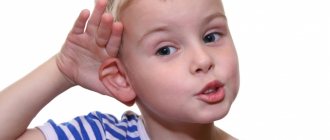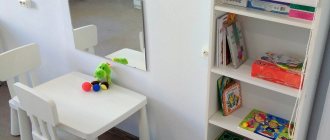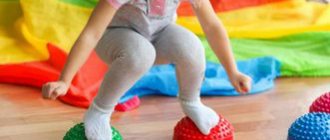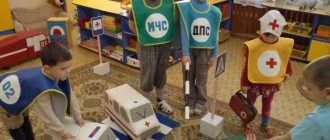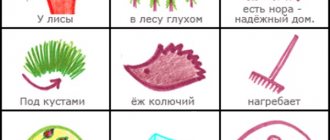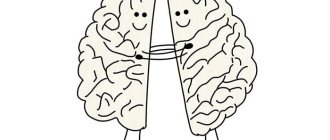If you think that your child is not yet old enough to master the basics of mathematics, then you are deeply mistaken. Various early development methods and a variety of didactic materials not only contribute to the development of mathematical abilities in children, but also instill in them a love for the “queen of the exact sciences.” One of these methods is the development of George Cuisenaire, who forced us to take a fresh look at the counting sticks that are well known to us.
If you think that your child is not yet old enough to master the basics of mathematics, then you are deeply mistaken. Various early development methods and a variety of didactic materials not only contribute to the development of mathematical abilities in children, but also instill in them a love for the “queen of the exact sciences.” One of these methods is the development of George Cuisenaire, who forced us to take a fresh look at the counting sticks that are well known to us.
It is noteworthy that George Cuisenaire managed to create multifunctional didactic material that allows not only to teach children mathematics, but also has a positive impact on the development of fine motor skills, memory, attention, perseverance, visual-effective thinking, imagination, design and combinatorial abilities. At the same time, Cuisenaire sticks can be used both as an independent teaching tool and as additional material to the main early development method.
The purpose and objectives of the methodology
Cuisenaire sticks appeared thanks to the work of a Belgian teacher who invented special colored blocks - with their help it became possible to teach children basic mathematical operations in a visual playful form. This is the main goal of the technique. Its tasks are multifaceted:
- teaching numbers while playing;
- development of ideas about counting and color;
- the formation of a sustainable interest in mathematics as a science;
- development of logic, thinking, ability to act outside the box;
- Explaining basic arithmetic operations to your child - addition and subtraction.
An additional advantage of the set is the ability to offer children a large number of tasks and exercises, so they will not be bored. In a playful way, the child will gain an understanding of such complex concepts as the relationship between numbers and numbers, length, directions (up and down, left and right).
The essence of the technique
The idea is both simple and interesting. Children play well with sticks and at the same time learn useful skills rather than boring and tedious memorization. In the future, the child will be interested in doing mathematics.
As the sticks were introduced and used, their colors were slightly changed. But the meaning has not changed.
Principles of the methodology:
- Help the child master territorial concepts of space such as: more - less, higher - lower, right - left, between.
- We learn to divide the whole into its component parts.
- We develop imagination, independence, visual and auditory memory, and stimulate speech.
- We learn to analyze, draw conclusions, compare.
- We learn simple mathematical operations: addition, subtraction, approaching division and multiplication, fractions.
Description of the set
Cuisenaire sticks are a didactic set consisting of blocks, painted in 10 different colors and having sizes from 1 cm to 10 cm. The total number of bars included in the set may vary:
- in the simplest version there are only 116.
- The “classic” set includes 241 sticks.
To be able to offer your baby a huge number of games, you should choose a set with a large number of blocks.
Age characteristics
The sticks can be used from 1 year to 7 years, although the box says: from three years. You've probably noticed that games of this kind always indicate an age of three years or older, since the set includes small parts.
In my opinion, it can be used from a year. Although, look at your baby: some will be interested, some will not, but if you bought it and the child didn’t like it, it’s okay - it will sit for a while and will still be useful.
For one-year-old babies, of course, this is play material. It is not recommended to give small details or closely observe the game, since at this age children want to taste everything.
You can use a pacifier to prevent your baby from putting chopsticks in his mouth. We develop fine motor skills and tactile sensations, build simple figures, either according to diagrams or simply, it all depends on the interest of the baby.
Then, by the age of three, you can freely work from diagrams and brochures with tasks, study colors and build geometric shapes and other structures from them.
History of the technique
Colored counting sticks appeared thanks to the works of George Cuisenaire, after whom the technique is named. This Belgian teacher worked with elementary school students and noticed that many of them had difficulty learning arithmetic operations and did not understand how to perform them. He came to the idea that a visual didactic aid could help in solving these problems, allowing him to present abstract material in a concrete form. This is how Cuisenaire sticks appeared, which they began to use even in working with preschoolers.
The teacher suggested not only using the manual, but also actively turning to the game, so that the learning process would be easy and fun, and the kids would have fun. In many ways, Cuisenaire relied on the work of Maria Montessori and Friedrich Froebel in his concept.
The result of the teacher’s work was not only sticks, but also detailed recommendations for their use - diagrams. They are described in the book “Numbers and Colors”; they are a set of exercises and games, by performing which the child is immersed in the fascinating world of mathematics, gaining both basic skills and pleasure. It is recommended to work first under the strict guidance of parents, and then independently.
A few words about George Cuisenaire
Belgian teacher George Cuisenaire is the author of a unique method of early childhood development, having worked in school almost his entire life. Working as a simple teacher in primary school allowed Cuisenaire to put into practice various methods and teaching programs, compare them and “adopt” the most effective and efficient ones. He refined some of the techniques based on his own experience, and described the result in detail in his practical recommendations for teaching children music, geography, art and biology.
Cuisenaire sticks, now famous throughout the world, are also the result of careful refinement. Using the method of his German colleague Friedrich Froebel when teaching children mathematics, Cuisener noted the interest of children and, as a result, the high effectiveness of this method. Froebel's findings formed the basis of Cuisenaire's own method, which was called “Color Numbers.”
Best age
The instructions for the sticks indicate that children from three years old should practice with them, but under the supervision of adults, children can complete their first tasks at 2–2.5 years old. The technique becomes most popular in the senior group of kindergarten, when children are preparing for school in full swing. Experts note that you can, of course, play with sticks at an earlier age (from one year), but in this case the mathematical manual becomes just a game material, and quite dangerous due to the abundance of small parts. Therefore, it is best to postpone it until a more appropriate age, but in the meantime offer the child safe cubes and pyramids.
Disadvantages of the Cuisenaire technique
Almost all experts unanimously claim that Cuisenaire sticks have no disadvantages. Today, this didactic material is one of the best and most effective tools for introducing children to mathematics from a very early age. The opinion of experts is also confirmed by numerous enthusiastic reviews from parents who are already practicing the Cuisenaire method at home.
But, as you know, even in honey you can find a fly in the ointment. “Colored numbers” were no exception. The proverbial “fly in the ointment” can be considered the need for systematic joint (parents and children) activities with counting sticks. Otherwise, the effect will be practically unnoticeable.
Subscribe to our Telegram to stay up to date with important news in the field of education.
Operating rules
In order for games with Cuisenaire sticks to bring maximum results, you should select a task taking into account the age of the baby and his individual abilities. There may be several options.
- The youngest (2.5-3 years) are best at arranging the sticks and trying to organize them by color. The task can be complicated by asking the child to arrange the blocks in a certain sequence (for example, blue, red, black). This will also help you remember the colors.
- Even at 2-3 years old, a child can easily create a neat path using sticks of different colors.
- Gradually, you can move on to working with sizes, showing your child with a clear example what “more” and “less” are. The mother invites the child to find among the many the same stick as the one in her hand.
- No less interesting for children is the opportunity to put together a drawing using a ready-made diagram as an example. First, the kids completely repeat the pattern, then the parent invites them to complicate the task by slightly changing the pattern, adding something of their own to it. Thus, colored sticks become a kind of mosaic, which perfectly develops fine motor skills, imagination and attentiveness.
- Children 4-5 years old can be asked to build a ladder out of small blocks and count how many small sticks can fit in one large one. It will be interesting for them to discover the smallest or largest of them.
The use of sticks should be combined with other educational games, not forcing the child to sit and study, but focusing on his abilities and desires - this is the only way to prepare for school mathematics with benefit and pleasure.
What age of child are Cuisenaire rods designed for?
Actually, on the box it says from 3 years old... But personally, it seems to me that you can start at any age, if you, the parents, had such a desire.
In general, I believe that this is precisely one of the main advantages of Cuisenaire colored sticks. That they are almost ideal for children of different ages - from toddlers to primary schoolchildren.
For the little ones, this is simply entertaining game material. And they will help older children in mastering the laws of mathematics.
Pros of training
Working with teaching sticks brings many positive aspects:
- Helps develop fine motor skills.
- contributes to the formation of the baby’s thinking and intelligence.
- stimulates his creativity, because in order to come up with and put together a pattern, he will need to activate his imagination.
- teaches the child to concentrate, which is very useful for an older preschooler, who will soon have to constantly concentrate on the words of the teacher.
Despite the large number of advantages, it should be noted that the methodology is highly specialized - it is aimed exclusively at developing mathematical skills, so it is necessary to supplement it with educational games of a different focus.
Pros and cons of the technique
Regular practice with Cuisineer's sticks will help your baby develop a creative and intellectual streak earlier than other toddlers. Will help the baby to concentrate and concentrate better, to be more attentive.
The classes involve fine motor skills, imagination, and constructive thinking. Your child will understand and navigate basic mathematical concepts and will be able to easily solve simple addition and subtraction examples.
Of course, it is difficult to call it an independent methodology, since it does not involve comprehensive development, but a one-sided mathematical bias.
But it is an excellent addition and a wonderful useful, interesting pastime for a child. and does not conflict with any of the known development methods. It can be independently used both at home and in preschool and school institutions, which is where it has gained its popularity.
Best exercises
There are many exercises you can do using colored sticks. Let's get to know some of them.
Laying out the stairs
You can play with children 3-4 years old. Mom scatters a set of colored sticks in front of them; there should be 10 of them. The child’s task is to build a ladder out of them, placing the sticks from the smallest to the largest.
Further, the task becomes more complicated: there are already 20 sticks on the table (2 pieces of each size), the child must make a double ladder. When the exercise becomes successful, you can ask the child to make a square out of sticks. To do this, the largest stick is added to the smallest one, then a slightly larger stick is added to a slightly smaller bar, and so on. As a result, a regular quadrilateral should emerge, and the child will get the idea that parts can be made into a whole.
Building a house
Colored sticks can also be used for construction activities, inviting children to build a house: first for a large doll, then for a small one. This will help both the development of fine motor skills and understanding of sizes.
There is no need to limit children’s imagination; kids can build houses for dolls in a way that is convenient for them - arranging the bars horizontally and vertically. But if a mistake is made (for example, the house for a large doll turned out to be clearly smaller than the house for a small one), then it must be delicately pointed out and helped to be corrected.
This activity is suitable for children aged 3-4 years. The parent can help the child conclude: the more sticks used, the larger the house.
Bed for mice
An adult must prepare in advance two small figures of mice (or any other animals), and one of them should be noticeably thicker than the second. After that, he invites the child to make cribs out of sticks for them. The child’s task is to understand that a fat mouse requires a large bed, and a thin one requires a smaller one. The adult does not interfere in the creative process, but helps to prevent mistakes.
The following conclusion is drawn: the longer the stick, the wider the crib.
Making a square
To work, you will need a large set of sticks and the help of a parent. The child’s task is to fold a square. First, he combines the four smallest sticks, “ones,” and they become the center. Then four larger sticks are placed on the top and bottom of the square, left and right. The next row is formed in the same way. The result should be a large square.
The task can be complicated by asking the child to create a maze:
- first, the baby uses a ready-made diagram that the parent sketched;
- gradually moves on to his own creativity.
The optimal age for this exercise is 4-5 years.
Eight line-up
When children are already familiar with counting, you can perform a task with them that will help them prepare for the perception of arithmetic operations.
- The adult takes out a figure eight stick from the set. Invites the child to find single sticks in such a quantity that they are located on the “eight” (accordingly, eight of them will be needed). The child takes out the smallest sticks one by one and places them on the figure eight. It is concluded that one long stick contains eight small ones.
- Now the preschooler is asked to make an eight from other sticks, for example, 5 and 3. Find as many combinations as possible.
After this, it is concluded that one long stick includes two smaller ones of different lengths. For example, eight is five and three.
Horizontal and vertical
This task will help kids understand the position of bodies in space. First, the adult explains what a horizon is, then says that if you put a stick down, it will be horizontal. And if you put it, it will take a vertical position.
After the theoretical part, you should invite the child to consolidate his knowledge in practice by placing colored blocks vertically or horizontally. Further, the task becomes more complicated - the child is required to determine how the tree and the train are located in space, and place the didactic material accordingly.
Classes with Cuisenaire sticks are an excellent way to prepare a child for school, to develop his most important skills, the ability to fantasize, and understand colors and sizes. The patterns are varied, so the child has the opportunity to create a new pattern every day. Often this type of work is enjoyed by diligent children who enjoy all kinds of mosaics and puzzles.
Methodological aspects of using Cuisenaire counting sticks in preschool educational institutions
The developmental manual was invented by teacher George Cuisenaire from Belgium (his last name became the name). It is a set of blocks of different colors and sizes, combined into groups. Each is a parallelepiped with a cross section of 1 square meter. cm and length from 1 to 10 cm.
The kit includes groups of bars of different colors and lengths
This set is not an accident, but a thoughtful mathematical set: in it, each color and length has a correspondence to a certain number from one to ten. For example, a white stick - a cube with sides of 1 cm - symbolizes the number 1, and a pink one (2 cm long) - the number 2, etc. The set has various color modifications. However, blocks of identical length always have the same color.
Each stick corresponds to a specific number from 1 to 10
The sticks have another interesting feature: different colors can be combined into “families”. Thus, the red family (its shades are red itself, pink, crimson, burgundy, etc.) includes numbers that are multiples of two - 2, 4, 8. The blue family includes numbers divisible by 3 - these are 3, 6 , 9. Shades of yellow are divisible by 5.
The classic version of the set includes 241 elements. However, when working with preschool children, a simplified version is often used, represented by 144 parts: 36 white sticks plus 12 elements of other colors.
Cuisenaire counting sticks can also be presented in a flat version. The teacher or parents can make a set with their own hands from thick cardboard. In this case, the elements can be cut out larger (starting from a stick of 2x2 cm and ending with 2x20 cm). However, the details cannot be marked with numbers: preschoolers must themselves correlate the size of the block and the number.
You can make your own educational set from thick cardboard.
George Cuisenaire worked most of his life in an elementary school, where he put into practice various methods and teaching programs, and refined the most effective and efficient ones. Cuisenaire’s original method of teaching children mathematics was called “Colored Numbers”.
The essence of the Cuisenaire technique for preschoolers
The Cuisenaire set is intended, first of all, to develop mathematical concepts in preschoolers. This technique is suitable for both young children and future students: each age has its own level of tasks. Everything that is initially accomplished through practical manipulation is reflected in the child’s thinking. Working with counting sticks makes it possible to transfer external actions to the internal plane.
The Cuisenaire set is a set that makes it easy for children to demonstrate order and equivalence relationships. A variety of mathematical situations are hidden here. Since the number in the set is modeled from color and size, abstract concepts begin to form in the child’s thinking. And this is a natural consequence of his independent practical actions. The children master quantitative and ordinal arithmetic.
Cuisenaire's manual makes it possible to clearly show a preschooler a number series: the elements are arranged in a “ladder” from 1 to 10. At the same time, children better understand the concept of “more or less”: for example, that 5 is greater than 3 (one stick is longer than the other). A set of counting sticks is a wonderful way to explain to a child the composition of a number, the division of a whole into parts: a preschooler will easily remember that the number 2 is obtained from the addition of two units (in this regard, a stick 2 cm long corresponds to two sticks 1 cm each). This manual is also suitable for teaching more complex operations in mathematics - multiplication and division.
Counting sticks also improve measuring skills. By clearly observing that one element is longer or higher than another, the baby learns to compare them, masters the concepts of “shorter”, “longer”, “different”, “same”. Also, using this didactic material, you can practice the concepts of “right-left” and “mass” of an object.
The details of the set are interesting because children can work with them in both horizontal and vertical planes. Thus, the created model can be viewed in different ways. Cuisenaire's developmental manual helps not only in learning mathematics. This technique allows you to make letters, various shapes (a kind of mosaic), and three-dimensional structures from sticks. There are special schemes for this that can be found on the Internet or developed independently.
You can use sticks to lay out various images on a plane
To develop strong knowledge and skills, tasks using the Cuisenaire method should be offered to preschoolers regularly (at least once a week).
Advantages and disadvantages of the technique
The main advantage of the Cuisenaire method is the possibility of its use when working with children of different ages (both junior and senior schoolchildren). For kids, this is an exciting game material that will later help them master mathematical laws without boring memorization. It attracts with its colorfulness and versatility.
There is a fairly large assortment of albums, activity diagrams, and ready-made game scenarios available for sale and freely available online. The advantage of the technique is that it develops not only cognitive activity, but also fine motor skills, imagination, visual and spatial perception. The volume of the sticks and their differences in color and length allow the child to master sensory standards (size and color).
It is obvious that Cuisenaire's manual is universal and successfully complements other existing methods of teaching mathematics. Nevertheless, some parents consider the disadvantage of the manual to be the fact that it is imperative to practice with counting sticks with children systematically, otherwise the exercises will not bring noticeable results.
Problems of using counting sticks in preschool educational institutions
The use of Cuisenaire's manual in the pedagogical process of a preschool educational institution helps to solve many problems:
- Educational: Formation of the concepts of number and quantity, ideas about their relationship.
- Consolidation of quantitative and ordinal counting.
- Mastering the concept of “number composition”, teaching addition and subtraction skills.
- Formation of measurement skills (in particular, comparison of objects by their length, width and height).
- Consolidating knowledge of geometric shapes (by folding them from elements of a set).
In a pre-school group, as part of an in-depth study of mathematics (this can be circle work), using the Cuisenaire set, you can introduce children to arithmetic progression (the so-called color algebra).
Working methods
Cuisenaire rods are a multifunctional teaching material. To teach using this method, the teacher uses various techniques, primarily games. However, for activities to be successful, they must be appropriate to the age of the children and their level of development.
So, younger preschoolers first just need to be introduced to the set. Let the kids play with the sticks and make different patterns out of them if they wish. You can invite the children to build some kind of building from the elements. In the future, preschoolers can use the details in role-playing games (for example, as a product in a store or lipstick in a beauty salon).
Kids love to play with colored sticks
It is quite possible that during such games the children themselves will make certain discoveries: for example, that there are a lot of sticks, but among them there are elements of the same color and size, or if you put together 2 blocks of the same color, then along the length we will get a stick of a different color, etc. d. It is important to constantly invite children to examine the details, count them one by one, apply them to each other - thus, cognitive development is combined with sensory development.
Gradually, the teacher introduces tasks and exercises (again, games) with counting sticks. By completing them, children come to understand that each item in the set has its own constant number. Exercises should be diverse: aimed at improving ideas about magnitude, consolidating the concept of number, etc. They can also be complex in nature: solving a number of problems at once. When selecting tasks, you need to take into account their relationship (inclusion of general and increasingly complex aspects), compatibility with exercises where other didactic means are involved.
Since working with the Cuisenaire set is visual and effective in nature, in primary and secondary preschool age the main teaching method will be showing the teacher’s method of action simultaneously with an explanation. At the senior level, a diagram or verbal instructions will be enough.
The teacher’s help in completing tasks should be indirect: the teacher invites the child to think again and try a different course of action. We must strive to ensure that children show independence in choosing decisions, make suggestions and check them themselves.
To maintain the interest of preschoolers in cognitive activities, the teacher thinks through various surprise moments of the lesson and entertaining elements. For example, a real sun (toy) comes to the kids for a lesson, and they need to build a path to it. Game moments play a motivational role (build a dog house, a ladder for a doll, etc.). At the older preschool age, it is already possible to interest children in competitions (compiling numbers from sticks for speed, etc.).
Game characters help create motivation in preschoolers for any activity
Another important technique that accompanies manipulations with counting sticks is asking questions to preschoolers. This is relevant at any age. Questions make children’s perception more active, develop their speech, and help them comprehend the material.
As for the forms of working with the Cuisenaire set, the guys usually practice individually. You can combine them into subgroups of several people.
The advantage of the Cuisenaire Rod technique
With chopsticks it is convenient to perform a lot of different tasks and exercises, even sometimes not related to mathematics. As I mentioned above, they can be used to develop creativity, ideas about color, etc.
Thus, not a single child with Cuisenaire sticks will definitely get bored. I’ll tell you a secret, they really help me cope with various stressful life situations. You start working with them, and immediately all the anxious thoughts disappear somewhere. And before you there is an opportunity to create and be surprised, admire and rejoice.
Cuisener sticks article on the topic
Belgian primary school teacher George Cuisenaire (1891-1976) developed universal didactic material for developing children's mathematical abilities. In 1952, he published Numbers and Colors, a book dedicated to his teaching aid.
Cuisenaire sticks are a set of counting sticks, which are also called “numbers in color”, “colored sticks”, “colored numbers”, “colored rulers”. The set contains tetrahedral sticks of 10 different colors and lengths from 1 to 10 cm. Cuisenaire developed the sticks so that sticks of the same length are made in the same color and indicate a certain number. The longer the stick, the greater the numerical value it expresses.
Cuisenaire counting sticks produced by manufacturers differ in quantity, color and material (wood or plastic). To start, you can use a simplified set of 116 sticks. It contains 25 white sticks, 20 pink, 16 blue, 12 red, 10 yellow, 9 purple, 8 black, 7 burgundy, 5 blue and 4 orange. Cuisenaire sticks are mainly intended for activities with children from 1 to 7 years old.
Game tasks of colored sticks
Cuisenaire's counting sticks are a multifunctional mathematical tool that allows “through the hands” of a child to form the concept of a numerical sequence, the composition of a number, the relationships “more - less”, “right - left”, “between”, “longer”, “higher” and much more. . The set promotes the development of children's creativity, the development of fantasy and imagination, cognitive activity, fine motor skills, visual and effective thinking, attention, spatial orientation, perception, combinatorial and design abilities.
At the initial stage of classes, Cuisenaire sticks are used as playing material. Children play with them as with ordinary cubes, sticks, construction sets, as they play and practice, becoming familiar with colors, sizes and shapes.
At the second stage, the sticks already act as a tool for little mathematicians. And here children learn to comprehend the laws of the mysterious world of numbers and other mathematical concepts.
Counting sticks allow a child not only to develop abstract thinking, but also to identify logical connections in speculative concepts. As for specific practical goals, the most significant among them are:
formation of concepts of specification of counting and calculations in the form of numbers;
understanding of the “more-less” system;
practicing division and measurement skills, adding and subtracting;
mastering the essence of the concepts “equal”, “right”, “left”, “middle”, etc.;
development of creativity, modeling and design skills;
the formation of cognitive activity and a visually effective way of thinking, as well as all types of attention and detailed perception of the surrounding reality;
improvement of fine motor skills.
The age for starting “lessons” is determined individually, which is associated with different rates of development of the baby. But the average age for starting education in psychological and pedagogical literature is called 3 years. Meanwhile, some methodologists for teaching children admit that original lessons with rulers can be started as early as 1 year.
Most often, game exercises with Cuisenaire's manual are included in the content of a mathematical lesson. The teacher takes a topic and plays on it with the help of various entertaining tasks with counting sticks. For example, the teacher tells the children that a magic train has come to them - the sticks act as carriages in which the animals sit (pictures). Preschoolers practice ordinal counting - correlating each block with a specific number. Children can then build animal houses using counting sticks. Near the house there will be a ladder (laying out parts in decreasing lengths). As a gift for the animals, the kids lay out beautiful rugs from the Cuisenaire set.
Fairy tale modeling
Cuisenaire sticks can also be used in classes on speech development - to model fairy tales with their help (often this is done in conjunction with the use of Dienesh logic blocks). For example, a teacher recalls with preschoolers the fairy tale “The Wolf and the Seven Little Goats.” The guys describe the image of a wolf: angry, big, scary. The teacher, together with the children, decides to conditionally designate it with a long black stick. The goat will be a medium-sized yellow stick, and the kids will be small white ones. In the process of such activities, children better assimilate the plot of a fairy tale, understand the characters and appearance of its characters.
Analyzing the Russian folk tale “Teremok”, the teacher proposes to symbolically designate its heroes using Dienesh blocks, and then creatively modifies the ending of the work: the forest inhabitants felt sorry for the animals who were left without a house, and they decided to build a new large and beautiful tower for them - from Cuisenaire sticks.
After discussing the fairy tale “The Cat, the Rooster and the Fox,” preschoolers can choose to use counting sticks to create its hero, the colorful cockerel. This task can be practiced on the theme of any fairy tale you have read - a bunny (“Zayushkina’s Hut”), a turnip (“Repka”), vegetables from the garden (“Pykh”), etc. The Russian folk tale “The Three Bears” is well suited for modeling. where, using a set of sticks, children can depict 3 chairs, tables, cribs of different sizes. Using counting sticks you can model various fairy-tale characters
Literacy classes
Cuisenaire sticks are also useful in literacy classes. With their help, you can lay out individual letters and entire words. With the help of a developmental set, you can lay out letters and whole words. Abroad, this didactic material is used in English lessons to highlight stressed and unstressed syllables. This kind of work can also be practiced in our preschool institutions in classes in the preparatory group for school.
Playing games with Cuisenaire sticks in kindergarten
The development of mathematical concepts presupposes planned, systematic work. Therefore, game exercises are offered to children in a thoughtful order - from simpler to more complex. Due to this, the children gradually develop more and more complex skills, and their interest in learning new information is stimulated.
Games for preschoolers of younger and middle age
In the first half of the year, in the second junior group, the teacher conducts introductory games and activities with Cuisenaire sticks. After this (the second half of the junior group and the middle group), preschoolers are offered more complex games, many of them already have a specific plot. Games to familiarize yourself with didactic material: “Take as many sticks in your hand as possible” (first the right one, and then the left one). “Name the colors of the blocks” (not the entire set is laid out in front of the child, but a certain number). “Find the same stick” (by color or shape). “Show me the longest stick (or the shortest one).”
Games of the main stage (after familiarization): “Match the belt to the dress.” Pictures with images of dolls in beautiful dresses are laid out in front of the child. You need to choose a belt - a stick of a specific color - for the dress. "Build squares." The preschooler is asked to lay out 2 squares - each of the sticks has a different color. As a result, the conclusion follows: the longer the block, the larger the square will be. As a more complex option, you can build triangles, houses for a small bunny and a large fox. Filling silhouette figures. The child’s task is to fill in the picture with chopsticks. The color and length of the element are indicated there. In the future, the task becomes more complicated: the picture shows only the outline of the figure, its color and size are not indicated.
The last stage - the diagram hangs on the board, and the children complete the task on the table. "What changed?". The teacher places several sticks in front of the preschooler, the child remembers them, then closes his eyes. At this time, the adult removes or replaces one element. “Continue the pattern.” The child is invited to continue the pattern according to the sample (decorate a scarf or towel for mom, weave a beautiful rug for a kitten, build a fence, etc.). To do this, he must understand the pattern in the arrangement of elements (first by color or size, then these properties are combined).
“Build a ladder for the toy.” The peculiarity of the task is that the kids must lay out a three-dimensional staircase, placing the blocks on top of each other. The number of parts can be any, the main thing is that they are arranged in length in descending order. A teacher helps children build a structure of 10 parts. "High and low stairs." Children are offered cards with pictures of houses of different heights. Next to them you need to build stairs from sticks of the appropriate size.
“Draw an object.” The adult reads a short couplet and shows the corresponding picture, and the child must illustrate it using Cuisenaire sticks. For example: “Friends are running along the red path to Seryozhka” (you need to depict a path of red blocks).
"The fourth wheel." An adult places 3 identical sticks and 1 of a different color and length. A preschooler identifies the odd one out. "Make a train." The teacher asks the child to make a train of trailers for toy animals (small figures). But the trailers should be arranged from shortest to longest. Children make up pictures according to the diagrams that the teacher offers them.
“Fold down the ladder.” The ladder is folded in the same way, only the sticks are located on top of each other. The size of the ladder should be proportional to the size of the house. The kids’ task is to build a three-dimensional ladder from an arbitrary number of parts (the teacher helps to build from a large number of sticks. The children draw up pictures according to the diagrams that the teacher offers them.
Games for older preschoolers
Games for children aged 5–7 are combined into one block, since many pupils go to school after graduating from the senior group (at 6 years old). And it’s good if by this age they have the necessary skills that will be useful for further study.
Examples of games: “Show the number.” The sticks are arranged in ascending order (10 pcs.). The teacher shows a card with a picture of a number, and the children choose the corresponding stick. With his eyes closed, the preschooler must find 2 elements of the same length in the set (then 3 or 4).
“Measure the paths.” The cat and the kitten decided to measure the length of the path in steps. The cat took 5 steps, and the kitten took 10, although the distance was the same. The children’s task is to depict the steps of both characters using sticks (the concept of a conditional measure is mastered).
"Houses for nesting dolls." The teacher demonstrates the silhouettes of three multi-colored nesting dolls of different sizes and distributes a set of them to each child. The house of the red nesting doll is lower than the house of the blue one, and the house of the blue one is lower than the house of the yellow one. The guys must put out the corresponding pictures from the sticks.
"Bridges for Animals" According to the same verbal instructions, bridges are built for animals so that they can cross the river: a bear’s bridge is wider than a hare’s, and a hare’s is wider than a mouse’s.
“Fold the figure according to the description.” As instructed by the teacher, children lay out a rhombus, a pyramid, a bow, a snowflake, a gate, an isosceles triangle on the table and even “draw” a whole picture with sticks. Creating three-dimensional buildings from sticks, for example, a pyramid, a well, a tower, Baba Yaga’s hut, etc. Completing the construction of symmetrical pictures. The preschooler is presented with a picture that schematically depicts half of an object, for example, a glass. The child’s task is to complete the image in the same color scheme. Laying out letters and numbers at speed using the Cuisenaire set.
“Place the apples in baskets.” Beautiful juicy apples have grown on the apple tree, there are 10 of them. They need to be placed in two baskets in different ways (the composition of the number 10 is fixed). Children complete the task - make up the number 10 from two counting sticks, each of which corresponds to a certain number (for example, yellow and yellow - 5 and 5 or blue and white - 9 and 1, etc.). It turns out in which case the apples will be distributed equally.
“Weave a rug from sticks.” The children are asked to weave a rug according to certain rules: all rows must be different, each row consists of sticks that are the total length of a red one, the rug ends with a white fringe
Age 4-5 years with Cuisenaire sticks
Middle and then senior preschool age is a fertile period for introducing preschool children to mathematics. Now, with a slight movement of the hand, Cuisenaire's sticks turn into real educational didactic material, with the help of which the teacher introduces children to counting and arithmetic operations.
Related posts:
- Sensory ideas of children about color Sensory ideas of preschool children, stages of formation of sensory ideas about...
- Implementation of the conditions for designing a developing educational space using modern gaming technologies Conditions for designing an educational space in kindergarten using gaming technologies….
- What is "War and Peace" about? Summary of the novel “War and Peace” by chapters. All answers...
- Sensory standards Sensory standards in the psychology of child development. What standards need to be formed...
